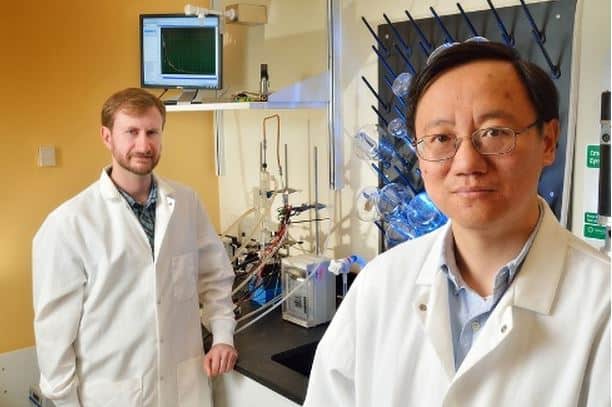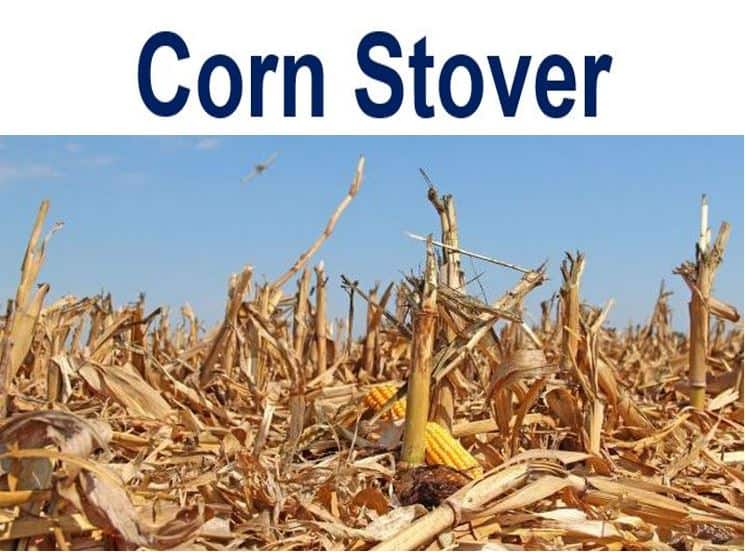A cheap way of producing hydrogen fuel from abundantly-available corn stover – the stalks, cobs, and husks – has been discovered by scientists at Virginia Tech in the US. This biological method for making hydrogen fuel significantly reduces the time and money it takes to produce zero-emissions fuel.
The researchers, who published their findings in the Proceedings of the National Academy of Sciences, say their discovery may help accelerate the widespread arrival of hydrogen-powered cars in a way that is economical and has extremely low carbon emissions.
Professor Percival Zhang, who works at Virginia Tech’s Department of Biological Systems Engineering, said:
“This means we have demonstrated the most important step toward a hydrogen economy – producing distributed and affordable green hydrogen from local biomass resources.”

Professor Percival Zhang (right) and Joe Rollin. (Image: Virginia Tech)
Next stage – to scale up production
Prof. Zhang and colleagues already have considerable funding for the next stage of the project – to scale up production to a demonstration size.
Director of the Florida Center for Renewable Chemicals and Fuels at the University of Florida, Lonnie O. Ingram, who is familiar with the study but was not involved in it, said:
“Although it is difficult to predict cost at this point, this work represents a revolutionary approach that offers many new advantages.”
“These researchers have certainly broadened the scope of our thinking about metabolism and how it plays into the future of alternative energy production.”
Lead author Joe Rollin, who was a former PhD student of Zhang’s at Virginia Tech, and co-founder along with Zhang of the start-up firm Cell-free Bioinnovations, said this work builds on previous research carried out by Zhang’s team on xylose, the most abundant simple plant pentose sugar.
The aim was to produce hydrogen yields from xylose that had been attainable in theory but never tried out in practice.
Breakthrough unique in two ways
Rather than relying on highly processed sugars, which is the case with other hydrogen fuel production methods, Zhang and colleagues used dirty biomass – the stalks and husks of corn plants – to create their fuel.
This brings down the initial expense of creating the fuel considerably, and also enables the use of a fuel source that is readily available near the processing plants, thus making the production of the fuel a local enterprise.

Corn stover consists of the leaves and stalks of maize plants left in a field after harvest.
Dr. Rollin used a genetic algorithm as well as a series of complex mathematical expressions to monitor each step of the enzymatic process that breaks down the corn stover into CO2 and hydrogen.
His analysis confirmed that this system uses both sugars – xylose and glucose – simultaneously, which significantly increases the rate at which hydrogen is released.
Before this study, biological conversions of these two sugars could only be done one after the other, not at the same time, which added time and costs to the process.
Capital costs greatly reduced with this method
One of the main obstacles to widespread hydrogen use has been the capital costs needed to produce the fuel from natural gas in large facilities. Another challenge has been the distribution of the hydrogen to fuel cell vehicle users.
Rollin’s model raised the reaction rates by a factor of three, which means the size of a facility need be no larger than a current gas (UK: petrol) station, which in turn reduces associated capital costs by about two thirds.
The main method today for producing hydrogen gas is to use natural gas, which is not cheap to distribute and causes fossil carbon emissions.
To create distributed hydrogen at affordable costs, product yield, reaction rate, and product separation need to be addressed.
As far as product yield is concerned, “the use of cell-free artificial enzymatic pathway not only breaks the natural limit of hydrogen-producing microorganisms by three times but also avoids complicated sugar flux regulation,” the authors wrote.
Zhang and colleagues also improved enzymatic generation rates. This reaction rate is fast enough to produce and distribute hydrogen at hydrogen-fueling stations. “The achieved reaction rate is at least 10 times that of the fastest photo-hydrogen production system,” the scientists said.
System generates high-purity hydrogen
The researchers observed the reaction at modest conditions, meaning that hydrogen can be separated easily from aqueous reactants and enzymes. Also, the enzymatic reactions used in this system generated high-purity hydrogen, which is perfect for fuel-cell vehicles.
The modest reaction conditions also suggest that the capital-requirements for building distributed hydrogen generating and fueling stations based on this technology are low.
Dr. Rollin said:
“We believe this exciting technology has the potential to enable the widespread use of hydrogen fuel cell vehicles around the world and displace fossil fuels.”
The study was partly funded by the National Science Foundation’s Small Business Technology Transfer program and the Shell GameChanger initiative.
Citation: “High-yield hydrogen production from biomass by in vitro metabolic engineering: Mixed sugars coutilization and kinetic modeling,” Joseph A. Rollin, Julia Martin del Campo, Suwan Myung, Fngfang Sun, Chun You, Allison Bakovic, Roberto Castro, Sanjeev K. Chandrayan, Chang-Hao Wu, Michael W. W. Adams, Ryan S. Senger, and Y.-H. Percival Zhanga. Proceedings of the National Academy of Sciences. Published April 6, 2015. DOI: 10.1073/pnas.1417719112.

